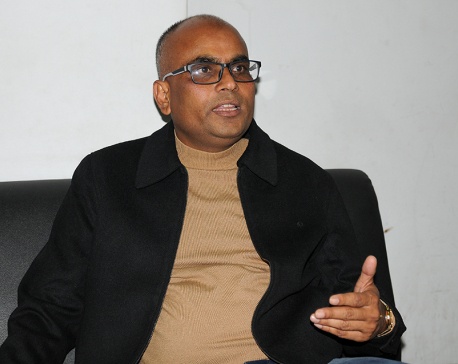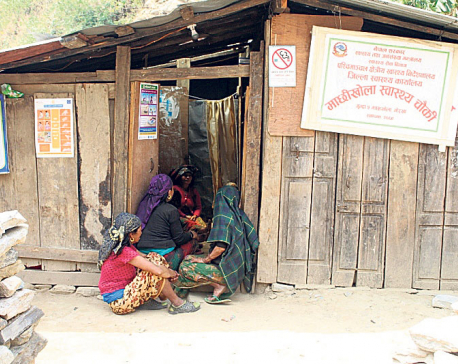
OR
'Locals should have say in monuments reconstruction'
Published On: January 30, 2017 12:20 AM NPT By: Republica | @RepublicaNepal

Jared M Koller is a PhD candidate in the Department of Archaeology at Boston University. Prior to joining PhD program, Koller served as a researcher for the Asian Cultural History Program, which is a part of the Smithsonian Institution's Anthropology Department in Washington DC. US Embassy brought Koller in Kathmandu for a series of cultural preservation and museum management seminars in coordination with major Nepali public museums. In addition to the trainings that focus on usage of new media and technology in museum management, he also discussed potential projects collaborations or partnerships with various institutions in Nepal. Koller spoke to Republica on the sidelines of his seminar on Friday. Excerpts:
How did you find the condition of museums in Nepal?
They are very different depending on the museums. First thing I noticed is some museums have cutting-edge technology in terms of presentation, and even how they are organizing their collections. And others seem to be catching up to manage things after the earthquake. I noticed that each museum here is trying to deal with its own type of cultural heritage. And that makes sense in many ways because you used to have three different kingdoms in Kathmandu Valley itself. And you have differences in terms of ethnicities, and identities within Nepal. It depends what makes sense to the local curator, and how they want to present the information. There seems to be differences in how information is organized.
You have closely studied the museums in the US, and you were even associated with the Smithsonian Museum. What do you think Nepal's museums should be doing to upgrade them?
Both my specialization at the Smithsonian's and my Ph D are digitization and web development. I think it is kind of next step here. So I will give you my example of a phone app. You go to one of the exhibits in the Natural History Museum at the Smithsonian's.
Visitors, when they enter the exhibit, they can download the app, and once they go there they go to one part of the exhibit and all other information comes up, even 3D representation and videos. It is more interactive. That's one thing I noticed here that can be brought to use. It's an easy technology. And, the second thing is promotion in terms of the website. It is very easy to create website these days. You do not need special knowledge.
What are the common problems that you saw in the museums in Nepal?
I do not say problems. But I think documentation is the first important step. That's why I am kind of pushing for digitization because it's flexible. When you create a written catalogue once, it's really accessible, especially when trying to compare large collections. You can share your information even with researchers across the world. I think my main recommendation is digitization.
What are the practices of US museums that you think Nepali museums should follow?
Earlier this week, I led a seminar with some of the museum specialists around Kathmandu. We also discussed creating a website. Wordpress and the likes allow you to create websites for free. And you can create online galleries. So, I think that is one of the main emphasis and they were more enthusiastic; about that and about being able to promote your museums or your own collections. You got all museums and architecture amazing. You obviously has robust tourism industry. But I still think they do not know about the objects of cultural history and some people never make it here. And they can at least know about Nepal through websites.
What do you recommend for museum management in Nepal?
My personal recommendation is to create an inventory and have more collaboration among all museums. That's why database is crucial. This is an easy way to share the information not just internationally but also among the people within the museum or museum specialists in Nepal. That's what I think is the base you can start with. This helps you know what you have and what others have. When I go and visit a lot of museums, for example Patan, the curator there is extremely knowledgeable. But it is nice to have everything together; everything together in some sort of database system.
Did you find the reconstruction of cultural heritage sites being done properly in Nepal? What is your impression about it?
I should mention that I am not an architect. I focus on digitalization, and 3D modal of it. But I am aware that there is a debate about whether to restore monument as it is originally formed or make it safer. This is a difficult issue. I think I lie more towards as minimal modification as possible.
Earthquake last year destroyed a large number of archaelogically important buildings. There is a debate going on in Nepal whether to restore, for instance, Dharahara tower as it stood originally or preserve the debris for the future generation. What do you think is the right thing to do?
I personally feel these buildings belong to the local community. So, it's their choice how they want to restore them. But I just feel you have to be upfront about other potential designs in the past. So I do not think that there is one personal principle for restoration. I think in general these buildings are used by the community, and they should have the first say in deciding how to restore them.
You May Like This

"It is wrong to say we have no money for federal infrastructures. We have plenty"
Financial viability of the federal model has been a big concern of Nepali policymakers and economists in recent times. Many... Read More...

Locals' participation helps speed up monuments reconstruction in Bhaktapur
BHAKTAPUR, Dec 29: Septuagenarian Saila Poju, a local of Byasi of Bhaktapur, has been constructing the wall of the historic Vatsala... Read More...

Delay in reconstruction by I/NGOs irks locals
GORKHA, Aug 23: National and international non-governmental organizations have so far failed to live up to the commitments they made... Read More...




Just In
- Health ministry to conduct ‘search and vaccinate’ campaign on May 13
- Indian customs releases trucks carrying Nepali tea, halted across Kakarbhitta
- Silent period for by-election to begin from midnight
- SC issues short-term interim order to govt and TU not to take immediate action against TU legal advisor Khanal
- National consultation workshop advocates to scale up nutrition smart community in Nepal
- Patan High Court issues short-term interim order to halt selection process of NTB’s CEO
- NEPSE inches up 0.15 points; daily turnover increases to Rs 2.53 billion
- Bagmati Govt mandates tri-lingual signboards in offices














Leave A Comment